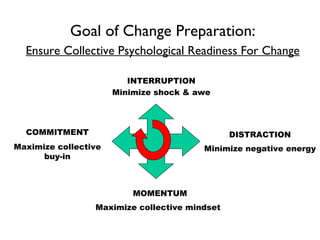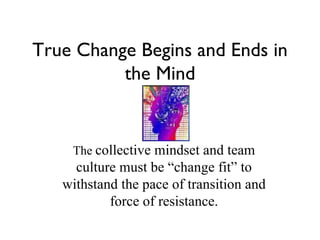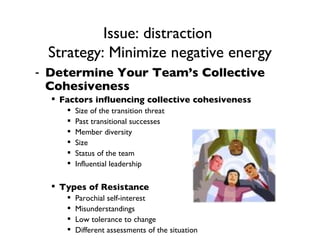@@Preparing People For Change V3
- 1. Preparing People for Change Collective Adaptation Through Positive Osmosis
- 2. The Change Process Sequence of organizational events or a psychological process that occurs over time.
- 3. Goal of Change Preparation: Ensure Collective Psychological Readiness For Change INTERRUPTION Minimize shock & awe DISTRACTION Minimize negative energy MOMENTUM Maximize collective mindset COMMITMENT Maximize collective buy-in
- 4. Two Scenarios Grand River Hospital Dept. of Laboratories External Driver Transition from discrete departments to integrated healthcare delivery Mitra Imaging Inc./AGFA HealthCare Internal Driver Transition from a single diagnostic imaging software provider to become part of an integrated software solution provider
- 5. Organizational Similarities Highly skilled professionals Transition from the known to the unknown Highly loyal to people within the organization Well established workplace practices ŌĆō both formalized and adhoc External demands by customers, changes in the industry and other economic forces were forcing change upon the organization
- 6. 5 KEY TRUTHS must be accepted by all team members to unfreeze the institutionalized mindset: Transition will fundamentally change the way business is delivered Transition will fundamentally change the way in which we work together Transition will occur with or without me We have a choice to get involved with determining our destiny or to leave our destiny to others Our ability to adapt will determine the joy in the journey and the success of our final outcome
- 7. Areas of Anticipated Resistance Politics and self-interest Low individual tolerance for change Misunderstanding Lack of trust Different assessment of the situation A resistant organizational culture
- 8. True Change Begins and Ends in the Mind The collective mindset and team culture must be ŌĆ£change fitŌĆØ to withstand the pace of transition and force of resistance.
- 9. Minimize shock and awe - interruption Objective: To increase awareness by exposing the mindset to a new and different reality Diagnose the level of awareness ŌĆō none, low, high Mood ŌĆō hostile or friendly Try to anticipate individual response ŌĆō excitement or grief, is it the beginning or the end? Scope + impact of impending change = scale of interruption Level of involvement of the team in change project
- 10. Issue: interruption Strategy: Minimize shock and awe Start a dialogue of future scenario brainstorming (covert visioning) Systematic collection of information relevant to impending organizational change. Review and analysis of new information can contributes to unfreezing by showing that a problem exists. New information can also clarify the problem and begin to suggest possible alternatives for future scenarios Let them subtly see their peers and the future e.g. Attending tradeshows, reading industry trend magazines, attend planning meetings etc.
- 11. Issue: distraction Strategy: Minimize negative energy Objective: To determine the collective forces both for and against the impending transition Determine Your TeamŌĆÖs Collective Cohesiveness Identify Opportunities for Honest Communication Assess Current & Future Team Commitment
- 12. Issue: distraction Strategy: Minimize negative energy Determine Your TeamŌĆÖs Collective Cohesiveness Factors influencing collective cohesiveness Size of the transition threat Past transitional successes Member diversity Size Status of the team Influential leadership Types of Resistance Parochial self-interest Misunderstandings Low tolerance to change Different assessments of the situation
- 13. Issue: distraction Strategy: Minimize negative energy Identify openings for honest communication aboutŌĆ” Transitional Needs Transitional Fears Past history of change experiences - good and bad Potential for obsolete practices and procedures Opportunities for improvement Transition Expectations and Outcomes Strategies to deal with dysfunctional behavior and sub-optimal performance
- 14. Issue: distraction Strategy: Minimize negative energy - Assess Current & Future Team Commitment Ask the tough questions: Unless there is a commitment from team members to carry through with the proposed solution to a problem, the team's performance will diminish. Be aware: Commitment to change is lacking is when team members agree without hesitation about the need for change Fear of a loss of mastery, status ŌĆō Encourage pre-experimentation to allow people to adapt and learn through trial and error, then develop confidence to succeed before beginning the real project task. Keep your ear to the grapevine ŌĆō diffuse rumors with the truth to minimize energy consumption
- 15. Issue: Momentum Strategy: Maximize collective mindset Objective: To identify and exploit the collective personalities, values, and talents within the team to create increased momentum for change Without fail, model trust and respect and implement it as a core relationship competency ŌĆō key stone behavior for all cooperation and commitment within the team during the transition period * STOP HERE IF TRUST AND RESPECT ARE NOT A DEMONSTRATED CORE COMPETENCIES WITHIN YOUR TEAM
- 16. Maximize collective mindset ŌĆō momentum Begin to develop the high performance team mindset ŌĆō all for one and one for all Look for a emerging transformational leader Frame the Message - present resisting change as a lost opportunity for improvement Consider the pace of change Create positive energy relationships by ensuring a climate of cooperation, compassion, tolerance, forgiveness, and gratitude Encourage friendship building Think holistically - provide an opportunity for everyone to participate and be involved ŌĆō no missing links
- 17. Issue: commitment Strategy: Maximize collective buy-in Take the temperature of the day Continue to model trust, respect, enthusiasm, confidence and other positive influential behaviors Be prepared to negotiate ŌĆō define the goal not the path Immediately and publicly recognize creativity, innovation, positive team language and other positive behaviors Be available 24/7 to discuss and clarify rumors and misinformation Promote ownership of the change process ŌĆō greater involvement = greater commitment. Co-opt selective resistors to lead change initiative Coercion as a last resort ŌĆō change or else
- 18. Strategy: Ensure collective readiness for change Build the Case for Change Define new roles and behaviors Benchmark Best Practices Institute Symbolic Events Understand the concept of change management - create a new language Understand the gaps and or challenges that must be overcome ŌĆō ŌĆ£what will it takeŌĆØ Confirm support from the top Understand how we will support each other when the going gets tough Understand how we will celebrate each other and the small and big wins and milestones along the way


















